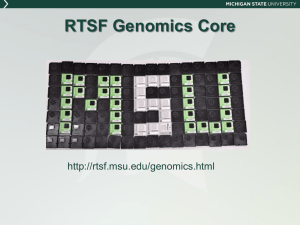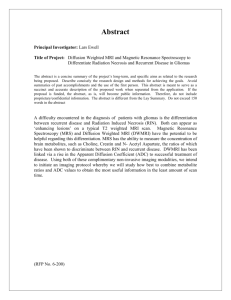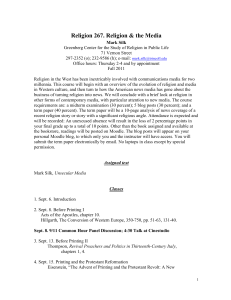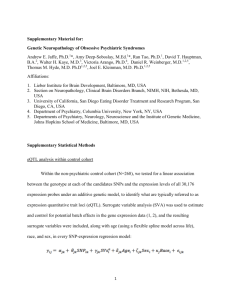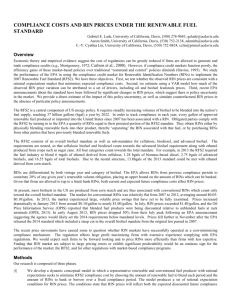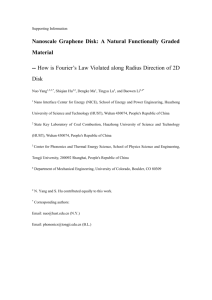FUL
advertisement
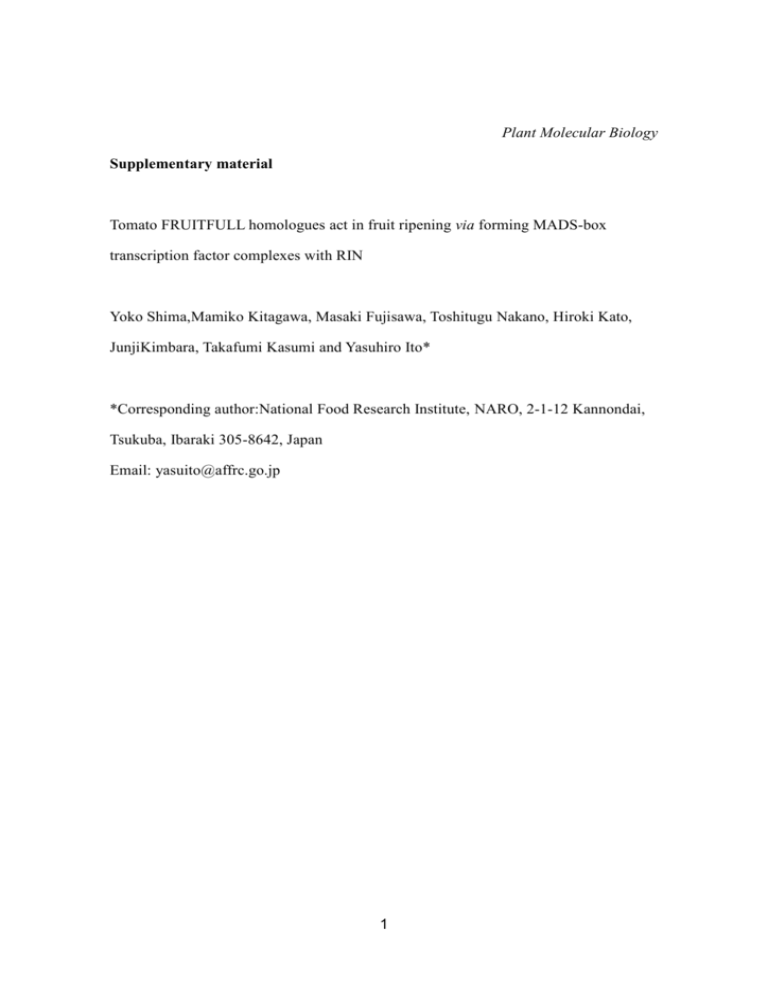
Plant Molecular Biology Supplementary material Tomato FRUITFULL homologues act in fruit ripening via forming MADS-box transcription factor complexes with RIN Yoko Shima,Mamiko Kitagawa, Masaki Fujisawa, Toshitugu Nakano, Hiroki Kato, JunjiKimbara, Takafumi Kasumi and Yasuhiro Ito* *Corresponding author:National Food Research Institute, NARO, 2-1-12 Kannondai, Tsukuba, Ibaraki 305-8642, Japan Email: yasuito@affrc.go.jp 1 Sup. Table 1Primers used for this study Gene Primer name Primer sequence (5’ to 3’) LeFUL1F AAACCATGGGAAGAGGAAGAG LeFUL1R AATGAGCTCTTTTAATTATTAAGATGACG LeFUL2F TTACCATGGGTAGAGGAAGAG LeFUL2R AATGAGCTCTTTAACCGTTGAGATGGCG LeFUL1R3-SacI CGAGCTCAGTCCTTTTTTTGAAGC FUL1-F3NcoI GACCATGGAGCACCAGCTTGATTC Analysis FUL1 FUL2 FUL1/ FUL2 of theFUL1proteinexpressing vector Construction of theFUL2proteinexpressing vector Construction of theFUL1 RevpEU3aEcoRI GTGAATTCTATACAAAACCAC CAC-F CCTCCGTTGTGATGTAACTGG CAC-R ATTGGTGGAAAGTAACATCATCG Constructionof the FUL1-F CAACAACTGGACTCTCCTCACCTT FUL1-R TCCTTCCACTTCCCCATTATCTATT FUL2-F CACACCCCTTTAACAATCTTCACA FUL2-R GCGATGATCCTTCTACTTCTCCAT RIN-F ATGGCATTGTGGTGAGCAAAG RIN-R GTTGATGGTGCTGCATTTTCG F ATCATACGATCACAAACGAGCTATTC R ATTCACACCACCTTTAAACCCTTAC F AGAATAGCGTAGAATTCATATAAGTAAAAG R AACTTTCGGGGGAAAACAAA F CTCCGCATACGACTAGCGACT R CACTTTTTGGGGGTAATGGATG F ACGAGGAGTAAGGTTTGCAACGAC qRT-PCR FUL2 qRT-PCR RIN qRT-PCR ACS21) ChIP-PCR ACS41) ChIP-PCR PSY1-a1) ChIP-PCR 2 FUL1 expression vectorfor Y2H experiment Reference forqRT-PCR FUL1 or FUL2proteinexpressing vector orFUL2protein CAC PSY1-b2) Construction ChIP-PCR R TGACTTGTCCAATAATTTAGGGCG F ATTTTAAACTTATTCTATAACTGGATTTCA R ATTCCAACTCTAATTTGTTATAGTCAAGA F CAATAGGCTTCGAAACTATGTAGAGG R AAAAATATTAAAAGGAAATGCTTCACT F CCATCAATGATCGGAATGGAAG R TCAGCAATACCAGGGAACATTG F CCTAGTATTGTGGGACGTCC R TAGATCCTCCGATCCAGACA F TAGACATGAACAGCCTTCTC R GGAGATCAATCCTAGCCTTG RIN1) ChIP-PCR FUL11) ChIP-PCR Actin1) ChIP-PCR Actin3) Control for RT-PCR rin3) RT-PCR 1) The primers forripening-induced genes were used in a previous study(Ito et al. 2008; Fujisawa et al. 2011; Fujisawa et al. 2012). 2) The primersforPSY1-bwere used in a previous study (Martel et al. 2011). 3) The primers were used for RT-PCR in Supp. Fig. 3. 3 Supplemental Figure 1Homodimerization of the RIN protein in yeast cells. a.Schematic of the full-length RIN and two types of truncatedproteins expressed in yeast cells.b.Identification of a domain required for the homodimerization of RIN by yeast two-hybrid assay. As shown in the left panel, either RIN-MIK(bMIK) or RIN-MIKC215 (bMIKC215)was expressed in yeast cells as a bait protein, and eitherRIN-MIK (pMIK) orRIN-MIKC (pMIKC) wasexpressed as a prey protein.Three independentcolonies of yeast expressing each combination of the bait and preyproteinswere spread on SD/-Leu/-Trp medium (control medium) orSD/-Leu/-Trp/-His/-Ade medium (selective medium).We did not examine the RIN-MIKC protein as a bait because RIN-MIKC has a transcription activating activity and the yeast cells expressing RIN-MIKC as a bait protein grew on the selective medium without interaction with a prey protein (Ito et al. 2008). The yeast cells grew only when expressing bMIKC215 and pMIKC, demonstrating that the C-domain is indispensable to form the homodimer. 4 Supplemental Figure 2 Two hypotheses for complex formation of FUL1 with RIN. The figure shows a schematic of a gel retardation assay with FUL1, RIN and RIN-MIK (tRIN). The gel retardation assay with RIN and tRIN gives three signals, RIN/RIN, RIN/tRIN, and tRIN/tRIN (center, Fig, 4a lane 6). Two possible hypotheses for complex formation between FUL1 and RIN are predicted: In hypothesis I, FUL1 would bind to the RIN homodimer; thus in the experiment in the left panel, three types of RIN dimersexhibited in the center panel would be super-shifted by FUL1. A super-shifted signal composed of FUL1, RIN and tRIN is indicated by a red arrow. The super-shifted signalwas, however,never found in the actual experiment (Fig. 4a, lanes3 and 7). In hypothesis II,FUL1 would form a heterodimer with RIN or tRIN. The two DNA binding signals generated by each heterodimer would correspond to the experiments with RIN and FUL1 (Fig. 4a, lanes1 and 5) or tRIN and FUL1 (Fig. 4a, lanes4 and 8), but no novel super-shifted signal would be found. 5 Supplemental Figure 3Fruitsof rinmutants used for the ChIP analyses in this study. a.The rinmutant fruits used in this study. The fruits were harvested at ages identical to the green and pink coloring stages of wild type fruits. The latter stage rinfruits exhibited a yellow color; thus we referred to the fruits as yellow stage fruits in the text. b. Expression of the rinmutant gene in the rin mutant fruits used for the ChIP assay in this study. A fraction of the fruits used for the ChIP assay was used for the expression analysis. The mRNA was extracted and analyzed by RT-PCR with a primer pair specific to the rinmutant allele (Supp. Table 1). Green fruits did not express the mutant gene but yellow fruits did. The Actin gene was used as an internal control. . 6 Supplemental Figure 4Gene structures of FUL1 and FUL2. Both FUL1 and FUL2 consist of eight exons and seven introns, and the lengths of the exons1 to 6 are conserved between the two paralogs. 7 Supplemental Text Construction of the plasmids used in this study Primers for gene amplification are listed in Supp. Table1. Theplasmids expressing FUL1 or FUL2 for in vitro protein synthesis system were constructed as follows. The coding regions of FUL1 and FUL2 were amplified with oligonucleotide primers: for FUL1, LeFUL1F and LeFUL1R; for FUL2, LeFUL2F and LeFUL2R. The resulting fragments were digested with NcoI and SacI and then were inserted into the same restriction sites of pEU-3a vector (Ito et al. 2002). The resultingplasmids were designated as pEU-FUL1 and pEU-FUL2, respectively. The DNA fragment encoding the C-domain truncated FUL1 was amplified from pEU-FUL1 with oligonucleotide primers LeFUL1F and LeFUL1R3-SacI. The amplified fragment was digested with NcoI and SacI and then was inserted into pEU-3a, resulting in pEU-FUL1-MIK. The DNA fragments encoding the C-domain truncated FUL2 were amplified from pEU-FUL2 with oligonucleotide primers LeFUL2F and LeFUL1R3-SacI, which is the same primer used for FUL1 because the priming site shows only a single-base substitution between FUL1 and FUL2 without amino-acid substitution for the encoding proteins. The amplified fragment was inserted into pEU3a in the same manner as the construction of pEU-FUL1-MIK, resulting in pEU-FUL2-MIK. The tKC region of FUL1 and FUL2 within pGBK-FUL1-tKC and pGBK-FUL2-tKC (described below) were excised by digestion with NcoI and SacI and cloned into pEU3a, resulting in pEU-FUL1-tKC and pEU-FUL2-tKC.The plasmid vector expressing whole RIN protein (pEU-RIN) and the C-terminal domain truncated RIN protein (pEU-MIK) was prepared previously (Ito et al. 2008). To construct bait vectors for yeast two hybrid experiments, pGBKT7 (Takara) 8 was used. The DNA fragments including the coding region of FUL1 or FUL2 were excised from pEU-FUL1 or pEU-FUL2 by digestion with NcoI and EcoRI. The excised fragments were inserted into pGBKT7 at the same restriction sites, and the resulting plasmids were designated pGBK-FUL1 and pGBK-FUL2. Similarly, pEU-FUL1-MIK and pEU-FUL2-MIK were digested with NcoI and EcoRI and the C-domain truncated FUL1 and FUL2 (FUL1-MIK and FUL2-MIK) were cloned into pGBKT7, resulting in pGBK-FUL1-MIK and pGBK-FUL2-MIK. To clone a partial FUL1 fragment composed of the truncated K-domain and whole C-domain (FUL1-tKC), the DNA fragment was amplified from pEU-FUL1 with the oligonucleotide primers FUL1-F3NcoI and RevpEU3aEcoRI. The amplified fragment was digested with NcoI and EcoRI and inserted into pGBKT7, resulting in pGBK-FUL1-tKC. Because only a few nucleotide substitutions and no predicted amino acid substitutionswerefound between FUL1 and FUL2 at the site of the primer FUL1-F3NcoI, the FUL2-tKC fragment was amplified with FUL1-F3NcoI and RevpEU3aEcoRI. The amplified fragment was inserted into pGBKT7 after digestion with NcoI and EcoRI, resulting in pGBK-FUL2-tKC. The bait vectors expressing the full length or part sequence of RIN (pGBK-RIN, pGBK-MIK, pGBK-MIKC215 and pGBK-KC) were constructed previously (Ito, et al. 2008). To construct prey vectors, pGADT7 (Takara) was used. The DNA fragments including full-length or parts of FUL1 or FUL2 were excised from pGBK-FUL1, pGBK-FUL1-MIK, pGBK-FUL1-tKC, pGBK-FUL2, pGBK-FUL2-MIK and pGBK-FUL2-tKC by digestion with NcoI and BamHI and cloned into pGADT7 at the same restriction sites, resulting in pGAD-FUL1, pGAD-FUL1-MIK, pGAD-FUL1-tKC, pGAD-FUL2, pGAD-FUL2-MIK and pGAD-FUL2-tKC, respectively. The RIN coding region within pEU-RIN (Ito, et al. 2008) was excised by 9 digestion with NcoIand SacI and cloned into pGADT7, resulting in pGAD-RIN. The DNA fragments encoding the C-domain truncated RIN and the KC domain of RIN were excised from pGBK-MIK and pGBK-KC by digestion with NcoI and BamHI and cloned into pGADT7, resulting in pGAD-RIN-MIK and pGAD-RIN-KC, respectively. 10

